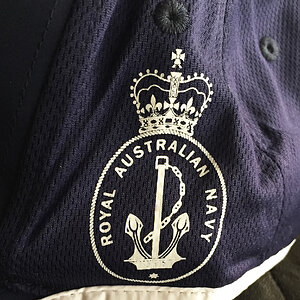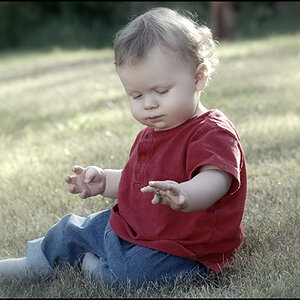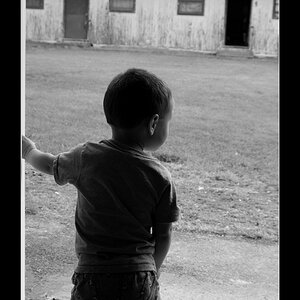Navigation
Install the app
How to install the app on iOS
Follow along with the video below to see how to install our site as a web app on your home screen.

Note: This feature currently requires accessing the site using the built-in Safari browser.
More options
You are using an out of date browser. It may not display this or other websites correctly.
You should upgrade or use an alternative browser.
You should upgrade or use an alternative browser.
Toned Gelatin-Silver Print
- Thread starter danalec99
- Start date
ksmattfish
Now 100% DC - not as cool as I once was, but still
- Joined
- Aug 25, 2003
- Messages
- 7,019
- Reaction score
- 36
- Location
- Lawrence, KS
- Website
- www.henrypeach.com
- Can others edit my Photos
- Photos NOT OK to edit
A gelatin silver print is a traditional BW print. The black in the image is actually silver. 99% of BW machine prints from labs these days use a minimal amount of silver, and mostly dyes to create create the image (like color prints). These are not gelatin silver prints.
Toning is the process of replacing the silver in the image with something else that is more colorful, or archival, or both. The most common toners are sepia (olive/brown) and selenium (no color change or sort of purple), but there is also iron toner (blue), copper toner (red), and a few others.
Selenium toner is commonly used because at low concentrations it doesn't really change the color of the image, although it can make the blacks deeper, and it increases the archival quality of the print (300+ years if stored correctly).
Toning is the process of replacing the silver in the image with something else that is more colorful, or archival, or both. The most common toners are sepia (olive/brown) and selenium (no color change or sort of purple), but there is also iron toner (blue), copper toner (red), and a few others.
Selenium toner is commonly used because at low concentrations it doesn't really change the color of the image, although it can make the blacks deeper, and it increases the archival quality of the print (300+ years if stored correctly).
danalec99
TPF Noob!
- Joined
- Mar 14, 2004
- Messages
- 8,345
- Reaction score
- 69
- Can others edit my Photos
- Photos NOT OK to edit
ksmattfish said:A gelatin silver print is a traditional BW print. The black in the image is actually silver. 99% of BW machine prints from labs these days use a minimal amount of silver, and mostly dyes to create create the image (like color prints). These are not gelatin silver prints.
Toning is the process of replacing the silver in the image with something else that is more colorful, or archival, or both. The most common toners are sepia (olive/brown) and selenium (no color change or sort of purple), but there is also iron toner (blue), copper toner (red), and a few others.
Selenium toner is commonly used because at low concentrations it doesn't really change the color of the image, although it can make the blacks deeper, and it increases the archival quality of the print (300+ years if stored correctly).
Thanks ksmattfish.
So, what do we do if we want a gelatin silver print?
oriecat
work in progress
- Joined
- Jul 7, 2003
- Messages
- 3,117
- Reaction score
- 19
- Location
- Portland OR USA
- Website
- www.moltenwords.net
Make one in your darkroom 
oriecat
work in progress
- Joined
- Jul 7, 2003
- Messages
- 3,117
- Reaction score
- 19
- Location
- Portland OR USA
- Website
- www.moltenwords.net
Pro labs might have hand printing b&w available.
- Joined
- Sep 2, 2003
- Messages
- 34,532
- Reaction score
- 7,557
- Location
- In the mental ward of this forum
- Can others edit my Photos
- Photos NOT OK to edit
Shoot a roll of B&W film and send it to Matt with a BIG check! :twisted:
santino
No longer a newbie, moving up!
- Joined
- Jun 17, 2004
- Messages
- 2,299
- Reaction score
- 54
- Location
- Austria, heart in Poland -->
- Website
- www.artofart.com
BIIIIG BIIIIIIIIIIIG check buddy, or your credit card 
ksmattfish
Now 100% DC - not as cool as I once was, but still
- Joined
- Aug 25, 2003
- Messages
- 7,019
- Reaction score
- 36
- Location
- Lawrence, KS
- Website
- www.henrypeach.com
- Can others edit my Photos
- Photos NOT OK to edit
danalec99 said:So, what do we do if we want a gelatin silver print?
Like Orie said...
danalec99
TPF Noob!
- Joined
- Mar 14, 2004
- Messages
- 8,345
- Reaction score
- 69
- Can others edit my Photos
- Photos NOT OK to edit
hmm, so...
1. Is there a considerable quality difference between silver gelatin and normal dyes? I mean, is there a quality difference in the final print?
2. Which one lasts longer?
3. And how big the check should be?
1. Is there a considerable quality difference between silver gelatin and normal dyes? I mean, is there a quality difference in the final print?
2. Which one lasts longer?
3. And how big the check should be?
ksmattfish
Now 100% DC - not as cool as I once was, but still
- Joined
- Aug 25, 2003
- Messages
- 7,019
- Reaction score
- 36
- Location
- Lawrence, KS
- Website
- www.henrypeach.com
- Can others edit my Photos
- Photos NOT OK to edit
danalec99 said:hmm, so...
1. Is there a considerable quality difference between silver gelatin and normal dyes? I mean, is there a quality difference in the final print?
2. Which one lasts longer?
3. And how big the check should be?
1) I think there is a very big difference between a machine print and a well done, hand printed, gelatin silver print. The proofs I get back from the lab are very nice, but my clients still purchase my hand printed gelatin silver prints for 5 times the lab price (for an 8x10), so they must think they are better also. A lot easier than discussing the merits of the gelatin silver print over a lab print would be for you to compare prints yourself, and come up with your own opinion. I'm sure there are many people who don't see a big enough difference to merit the extra cost.
2) If it's a chemical (dye) print from a lab then Kodak says their chems/paper last 20+ years, Fuji says 70+ years (with proper storage). Properly processed and stored an untoned gelatin silver print should last 70+ years. Add selenium toning to that and there are folks who say 300+ years. Studies/estimates seem to suggest that archival inkjet prints are more archival than a chemical print, and may last a very, very long time. Of course all of this depends on "proper storage" which basically means locked away somewhere never exposed to light, and that's no fun.
3) I charge $30 for a gelatin silver print on 8"x10" FB paper. This would include basic dodging and burning. This does not include toning. I think this is probably on the cheaper end of the scale, although there are labs that do offer gelatin silver printing for as little as half of this. They are better set up for volume. I'm mostly doing it for portrait and wedding customers of my own, who are having me print photos that I took. I only started offering to print other folks' work when the local pro labs stopped offering the services. Mostly I'm doing it for a couple of people who need their BW prints on FB for hand coloring.
If you have access to a darkroom and the time to print, then paper and chems for gelatin silver printing are really pretty cheap: RC paper is usually less than $0.50 a sheet, FB paper less than $1 a sheet, and all the chems necessary to print dozens of prints can be had for less than $20.
There's no big deal about gelatin silver prints. In the past almost all BW was done this way. The only reason they may seem exotic is that newer, faster, cheaper technology has dominated the market, and this is better for many consumers. Gelatin silver technology replaced earlier technologies which some people are still using: platinum printing, carbon printing, albumen printing, van dyke, cyanotype, and so on... And some of these are even more archival, and have their own subtle beauty.
If you are happy with your labs prints, that's fine. If you are really interested in gelatin silver prints I suggest you take a darkroom class. I do think that gelatin silver prints look better than BW machine prints or BW inkjet prints, but to me the greatest advantage is that I am printing and processing my own, and have complete control over the printing.
danalec99
TPF Noob!
- Joined
- Mar 14, 2004
- Messages
- 8,345
- Reaction score
- 69
- Can others edit my Photos
- Photos NOT OK to edit
Whoa!
Thanks Matt for that detailed explanation. I actually picked the term from photoeye, and was naturally wondering what it was. I haven't thought of a darkroom, yet . In future, I might; for the sake of experimenting. At this point, on a regular basis, I would prefer the digital way because of the ease.
. In future, I might; for the sake of experimenting. At this point, on a regular basis, I would prefer the digital way because of the ease.
Just one more question on this topic; what is FB and RC paper? Is it something like Matt/Glossy?[/i]
Thanks Matt for that detailed explanation. I actually picked the term from photoeye, and was naturally wondering what it was. I haven't thought of a darkroom, yet
Just one more question on this topic; what is FB and RC paper? Is it something like Matt/Glossy?[/i]
ksmattfish
Now 100% DC - not as cool as I once was, but still
- Joined
- Aug 25, 2003
- Messages
- 7,019
- Reaction score
- 36
- Location
- Lawrence, KS
- Website
- www.henrypeach.com
- Can others edit my Photos
- Photos NOT OK to edit
RC is resin coated paper. Meaning it's plastic coated.
FB is fiber paper. Meaning it's made of plant fibers, like many high quality papers.
RC paper usually has additives in the emulsion that speed up processing. RC developing times are about 1 min, while FB dev time is usually 2 or 3 min. RC fixes quicker than FB.
The plastic coating keeps RC paper from sucking up fixer, so it washes quicker (5 to 10 min). FB soaks up fixer so it can take up to an hour to wash.
FB is considered more archival, and is sort of the "fine art" standard.
Both kinds of paper are available in different finishes. Because of the plastic coating glossy RC is very, very glossy. While glossy FB looks more like semi-matte/pearl RC because of the texture of the fibers.
FB is fiber paper. Meaning it's made of plant fibers, like many high quality papers.
RC paper usually has additives in the emulsion that speed up processing. RC developing times are about 1 min, while FB dev time is usually 2 or 3 min. RC fixes quicker than FB.
The plastic coating keeps RC paper from sucking up fixer, so it washes quicker (5 to 10 min). FB soaks up fixer so it can take up to an hour to wash.
FB is considered more archival, and is sort of the "fine art" standard.
Both kinds of paper are available in different finishes. Because of the plastic coating glossy RC is very, very glossy. While glossy FB looks more like semi-matte/pearl RC because of the texture of the fibers.
danalec99
TPF Noob!
- Joined
- Mar 14, 2004
- Messages
- 8,345
- Reaction score
- 69
- Can others edit my Photos
- Photos NOT OK to edit
ksmattfish said:RC is resin coated paper. Meaning it's plastic coated.
FB is fiber paper. Meaning it's made of plant fibers, like many high quality papers.
RC paper usually has additives in the emulsion that speed up processing. RC developing times are about 1 min, while FB dev time is usually 2 or 3 min. RC fixes quicker than FB.
The plastic coating keeps RC paper from sucking up fixer, so it washes quicker (5 to 10 min). FB soaks up fixer so it can take up to an hour to wash.
FB is considered more archival, and is sort of the "fine art" standard.
Both kinds of paper are available in different finishes. Because of the plastic coating glossy RC is very, very glossy. While glossy FB looks more like semi-matte/pearl RC because of the texture of the fibers.
FB seems to be my kind of paper
Thanks Matt... it was awesome!
ksmattfish
Now 100% DC - not as cool as I once was, but still
- Joined
- Aug 25, 2003
- Messages
- 7,019
- Reaction score
- 36
- Location
- Lawrence, KS
- Website
- www.henrypeach.com
- Can others edit my Photos
- Photos NOT OK to edit
danalec99 said:FB seems to be my kind of paper
It is beautiful, but RC has it's place too. Check out the thread in the Darkroom forum where we're all bitching about FB paper curling....

Similar threads
- Replies
- 6
- Views
- 178
- Replies
- 0
- Views
- 128

![[No title]](/data/xfmg/thumbnail/33/33360-ff0b69685c94740bde3f53b6d7aa9af1.jpg?1619735924)
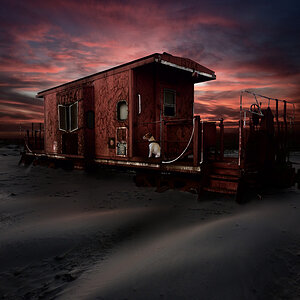
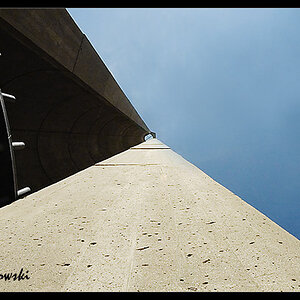
![[No title]](/data/xfmg/thumbnail/31/31095-2b52a6dcc956382cffdd384ae4d156f2.jpg?1619734612)
![[No title]](/data/xfmg/thumbnail/35/35667-929554d4a99c11e00cc6fb65672d03e0.jpg?1619737090)
![[No title]](/data/xfmg/thumbnail/33/33362-84aacb865117bf8cba89104b89e9b36c.jpg?1619735927)

